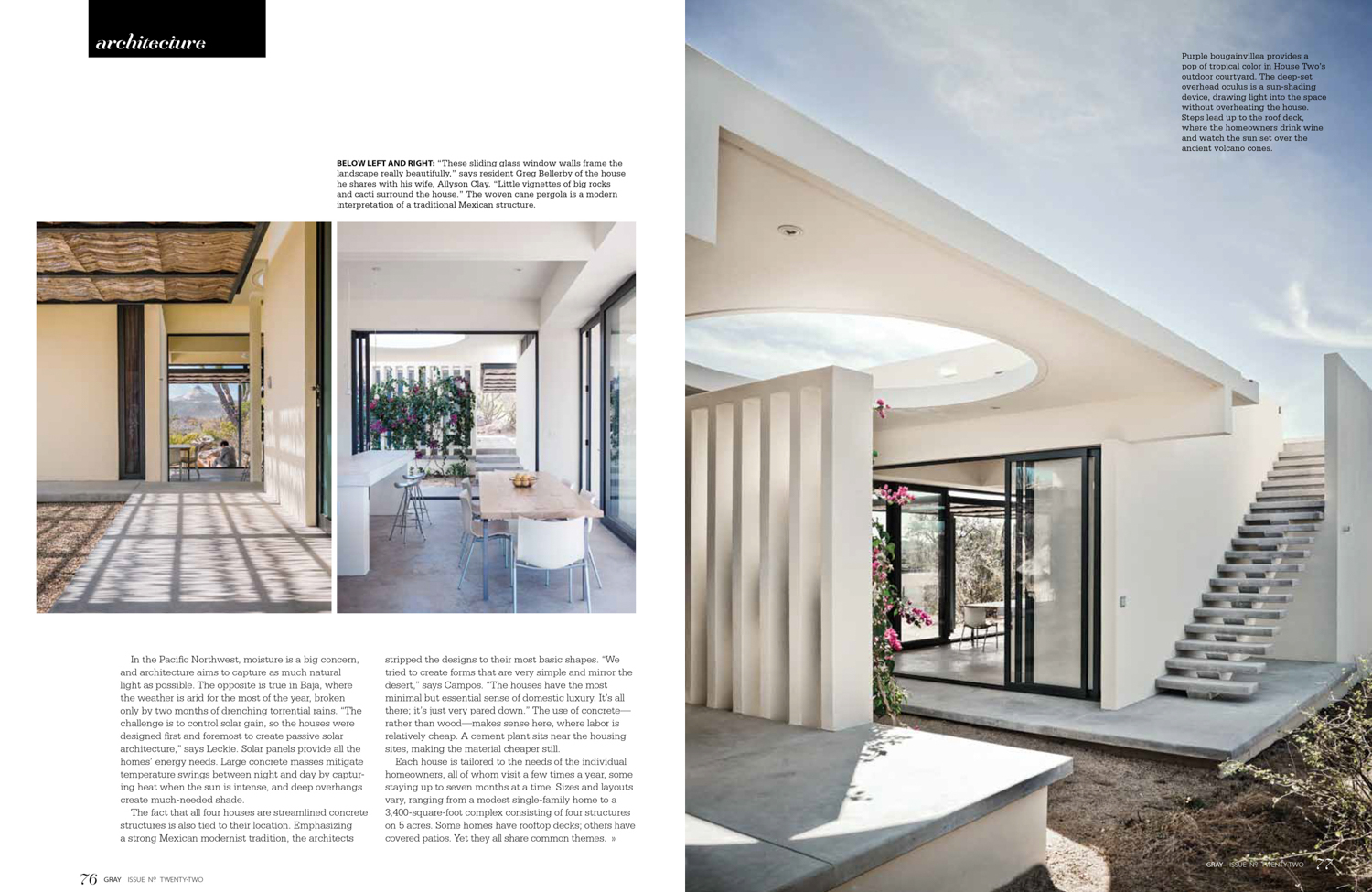"Desert Highs"
07.01.15 | Gray Magazine
In Los Zacatitos, on Mexico’s Baja Peninsula, four modern homes rest quietly on a dramatic desert landscape. Surrounded by cacti and massive boulders, with volcanic hills and the Sea of Cortez as its backdrop, the place feels worlds away from the lush British Columbia homeland of its residents. And that’s fitting. After all, when Vancouver-based architecture firm Campos Leckie Studio designed these houses, it was mindful of its Canadian clients’ desire to connect with the local environment.
Created over a period of almost 15 years—from the inception of House One in 1999 to House Four’s completion in 2013—the structures were a long time in the making, their construction slowed by rutted roads, limited access to materials, and the intricacies of the local building industry. First architects Javier Campos and Michael Leckie spent weeks getting to know the area and their clients, all Vancouver-area residents (with the exception of one homeowner from Whistler) who wanted vacation homes that lived lightly on the land. “You can’t design a house in Baja unless you actually experience the place,” says Campos. “What you can do in Mexico and what you can do in Vancouver are very different.”
Forget the rainscreen envelopes, curtain walls, and other fancy building systems that are used in the Pacific Northwest; in Baja, those technologies aren’t necessary for green design. Instead, as Leckie explains, “we’ve integrated relatively unsophisticated building technologies to create architecture that operates with a high degree of sophistication in response to the climate.” In other words, it’s the super-smart design, not high-tech systems, that keeps these houses off the grid. There’s no A/C: the houses all use passive ventilation—combining good airflow with overhead fans and breezeways—to keep indoor temperatures comfortable, even when it’s 100-plus degrees outside, and to mitigate often intense winds.
In the Pacific Northwest, moisture is a big concern, and architecture aims to capture as much natural light as possible. The opposite is true in Baja, where the weather is arid for the most of the year, broken only by two months of drenching torrential rains. “The challenge is to control solar gain, so the houses were designed first and foremost to create passive solar architecture,” says Leckie. Solar panels provide all thehomes’ energy needs. Large concrete masses mitigate temperature swings between night and day by capturing heat when the sun is intense, and deep overhangs create much-needed shade.
The fact that all four houses are streamlined concrete structures is also tied to their location. Emphasizing a strong Mexican modernist tradition, the architects stripped the designs to their most basic shapes. “We tried to create forms that are very simple and mirror the desert,” says Campos. “The houses have the most minimal but essential sense of domestic luxury. It’s all there; it’s just very pared down.” The use of concrete— rather than wood—makes sense here, where labor is relatively cheap. A cement plant sits near the housing sites, making the material cheaper still.
Each house is tailored to the needs of the individual homeowners, all of whom visit a few times a year, some staying up to seven months at a time. Sizes and layouts vary, ranging from a modest single-family home to a 3,400-square-foot complex consisting of four structures on 5 acres. Some homes have rooftop decks; others have covered patios. Yet they all share common themes.
Swimming pools mimic the way rainfall naturally settles in wet months. Massive walls of glass slide open to let homeowners live in a semi-outdoor setting, and the houses are integrated into the landscape rather than dominating it. Small lizards skitter through the spaces, and windows frame views of the volcano cones and ocean. And, since there’s limited access to big-box furniture stores in this tiny expat community, the architects built in beds, seating areas, and storage.
Though each home looks and lives slightly differently, all four are perfectly attuned to their setting and ideal for true getaways. “It couldn’t be more different from Vancouver here,” says Greg Bellerby, a retired art-gallery director and curator who owns House Two with his artist wife, Allyson Clay. Away from the noise and lights of their Pacific Northwest hometown, the couple walks and swims along miles of deserted coastline, enjoys afternoon siestas, and watches the sun set from their rooftop. As Bellerby explains, “It’s very spare, and that’s what we wanted—a simple place that is part of the landscape.”





